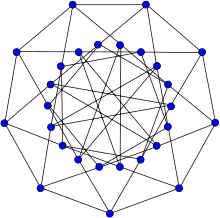Half-transitive graph
In the mathematical field of graph theory, a half-transitive graph is a graph that is both vertex-transitive and edge-transitive, but not symmetric.[1] In other words, a graph is half-transitive if its automorphism group acts transitively upon both its vertices and its edges, but not on ordered pairs of linked vertices.

The Holt graph is the smallest half-transitive graph. The lack of reflectional symmetry in this drawing highlights the fact that edges are not equivalent to their inverse.
Every connected symmetric graph must be vertex-transitive and edge-transitive, and the converse is true for graphs of odd degree,[2] so that half-transitive graphs of odd degree do not exist. However, there do exist half-transitive graphs of even degree.[3] The smallest half-transitive graph is the Holt graph, with degree 4 and 27 vertices.[4][5]
References
- ↑ Gross, J.L. and Yellen, J. (2004). Handbook of Graph Theory. CRC Press. p. 491. ISBN 1-58488-090-2.
- ↑ Babai, L (1996). "Automorphism groups, isomorphism, reconstruction". In Graham, R; Grötschel, M; Lovász, L. Handbook of Combinatorics. Elsevier.
- ↑ Bouwer, Z. "Vertex and Edge Transitive, But Not 1-Transitive Graphs." Canad. Math. Bull. 13, 231–237, 1970.
- ↑ Biggs, Norman (1993). Algebraic Graph Theory (2nd ed.). Cambridge: Cambridge University Press. ISBN 0-521-45897-8.
- ↑ Holt, Derek F. (1981). "A graph which is edge transitive but not arc transitive". Journal of Graph Theory 5 (2): 201–204. doi:10.1002/jgt.3190050210..



